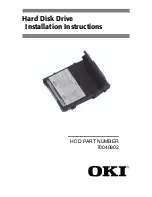
SanDisk SSD X100
Product Manual (Released)
Rev 1.0
© 2011 SanDisk® Corporation
14
Document No. 80-11-01842
1.5
Advanced Power Management
SSD X100 supports an advanced power management system that includes both Host Initiated
Power Management (HIPM) and Device Initiated Power Management (DIPM).
1.5.1
Slumber SATA low power mode
The SanDisk SSD x100 supports entering into Slumber SATA low power mode through DIPM
(Device Initiated Power Management) as well as HIPM (Host Initiated Power Management).
Upon completion of any command, in case of DIPM, the SSD will request the host to enter into
Slumber power.
1.6
Background Garbage Collection
Once the SSD X100 detects idle time, the flash management firmware can utilize the time the
device is idle in order to perform internal house-keeping operations. These internal house-
keeping activities include freeing up the space in the nCache by flushing and consolidating to the
MLC storage and rearranging the data in MLC array. Performing internal house-keeping activities
in background will significantly improve performance of the device, providing swift user
experience. These operations are executed internally and are transparent to the host. Any time
a new command is received from the host the internal operations will be terminated and the
host command will be serviced with minimal delay.
1.7
Performance Throttling
In order to protect the integrity of the data and prevent excessive heat dissipation, the SSD X100
utilizes an on-board/on-chip thermal sensor to monitor the SSD’s critical component junction
temperature. If the temperature rises above the allowable limit, the performance will be
reduced until the temperature decreases to an allowable level. This performance throttling
technique acts as a safety measure.















































